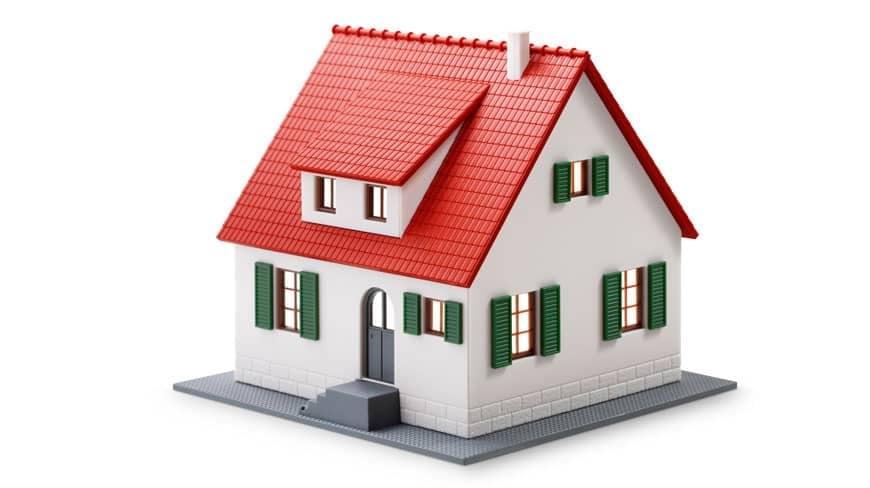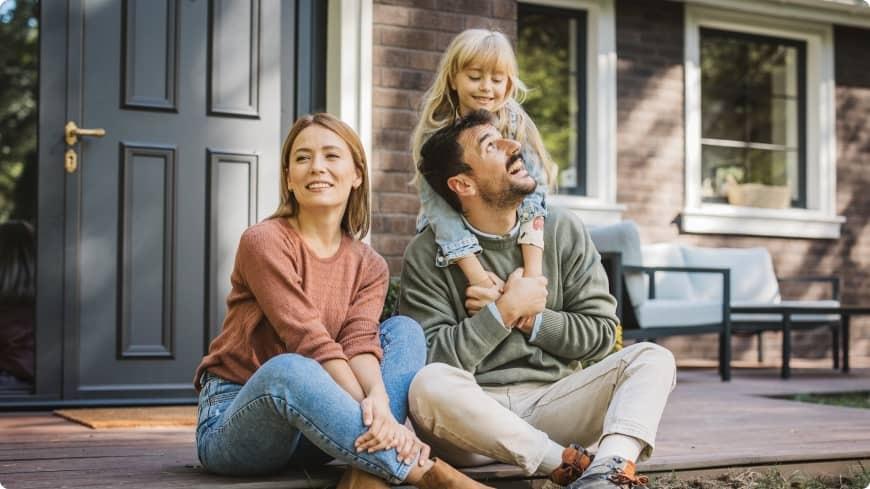How to buy a house with no money down

To buy a house without putting any money down, you will need to qualify for one of two government-backed home loans: VA or USDA. Typical down payments on a home are 20% of the purchase price. According to the National Association of Realtors the median down payment for all homes in 2024 was 18%. If that feels like too much and you don’t think you will qualify for either government loan, you still have options with down payments as low as 3%.
Find out how much you will need to put down when buying a home by talking with a lender and applying for your home loan today!
What is a zero-down mortgage?
A zero-down mortgage is a loan that does not require a down payment. This means that you will get a loan for the whole price of a home without putting anything upfront towards your home. If you don’t have a lot of money saved for a down payment, zero-down mortgages can seem like an appealing choice when looking to buy a home.
The only zero-down mortgages available are government-backed as lenders can find them risky. Without any money down, lenders think that borrowers might be quicker to default on the property without losing their initial investment.
If you qualify for a zero-down mortgage you won’t need a down payment, but you will need to pay closing costs of the property. Closing costs cover commissions, taxes, recording costs, and other expenses that arise when buying a home.
Types of zero-down mortgages
The two types of government-backed loans that offer zero-down payments are VA and USDA loans. Each one comes with their own rules and requirements.
VA Loan
The first zero-down mortgage is an exclusive offer on primary residences for military service members and spouses through the United States Department of Veteran Affairs. This loan is issued by a lender while the VA guarantees a portion of the loan.
The benefits of a VA loan are more than just not having a down payment. The VA is flexible on necessary credit scores, you could receive lower mortgage rates and there is no required mortgage insurance. Though, you will need to meet requirements from the VA and lenders to be eligible for a VA loan.
When applying for a VA loan your lender will need your Certificate of Eligibility (COE) from the U.S. Department of Veteran Affairs. You will also need a minimum credit score of 620 and to show your debt-to-income ratio.
USDA loan
Your other option for a zero-down payment mortgage is a USDA loan. If you are looking to purchase a home in a rural or suburban area you might be eligible for the United States Department of Agriculture’s loan, which includes 100% financing. This loan is offered to encourage development in rural areas.
Besides zero-down payments, other benefits that make USDA loans more accessible are: lower mortgage fees, no maximum purchase prices, below market interest rates and potentially having lower closing costs.
Some of the qualifications for a USDA loan are that your debt-to-income ratio cannot be more than 41% and your annual household income cannot exceed 115% of the median household income. The home you purchase will need to be your primary residence and within an eligible area.
Pros and cons of putting no money down on a mortgage
Not having to put money down on a mortgage seems like a great opportunity, and it can be. But it is important to know all the pros and cons of a zero-down payment mortgage before signing a contract.
Pros
You can buy a home with your savings staying intact
You may be able to move into a home sooner than if you needed to save for a down payment
Cons
No down payment means a bigger loan which can mean more interest paid over the life of the loan
You will start with less equity in your home than if you had a down payment
Without a down payment your monthly mortgage payments could be higher
Alternatives to zero down mortgages
If you don’t qualify for a government-back zero-down payment mortgage, you could still get a mortgage with minimal down payment.
Conventional mortgage
Conventional mortgages offered by Fannie Mae and Freddie Mac can get you a down payment option as low as 3% of the home’s purchase price. This option is mainly reserved for first-time homebuyers, but there can be exceptions to this. Other requirements include: getting private mortgage insurance, and not using the loan on an investment property or second home.
Less restrictive than the 3% conventional loan, a 5% down payment option isn’t backed by the government and a great choice for buyers able to afford a slightly larger down payment. These loans offer borrowers a choice of higher 15-, 20- and 30-year loans and higher loan limits. A 5% conventional loan still requires private mortgage insurance, which you can cancel after gaining 20% equity in your home.
Home Possible®
Through Freddie Mac, the Home Possible® loan has options for down payment options as low as 3%*. The income limit for this loan must be 80% of the area’s median income for everyone listed on the loan, instead of the whole household. Home Possible® loans can only be used on single family homes, condos, Planned Unit Development (PUD), co-ops, multi-unit properties and manufactured homes that meet guidelines.
HomeOne®
The HomeOne® mortgage loan is another loan offered by Freddie Mac with options for down payments as low as 3%, but this loan is only available for first-time homebuyers. There are no geographic or income limits to be eligible for a HomeOne® loan. Buyers looking at this loan type will have to take a home ownership education program. You can use a HomeOne® loan for a single-family home, townhome or condo.
HomeReady®
A HomeReady® loan is similar to a Home Possible® loan but offered by Fannie Mae and also has down payment options as low as 3%. For a HomeReady® loan you will need a minimum credit score of 620, but a 680 credit score is more desirable. First-time homebuyers are required to take a home ownership program and have private mortgage insurance.**
FHA loan with 3.5% down
FHA loans are the most popular type of government-backed loan in the United States. Down payment options for FHA loans can be as little as 3.5% and could be more accessible to people with credit scores minimums as low as 580. FHA loans are available for buyers with a 500 credit score if they can afford a 10% down payment option. Benefits of an FHA loan include lower interest rates and your mortgage insurance premium can be included in the loan amount.
Piggyback loan with 10% down
Piggyback loans can be the least accessible option if you are looking to buy a home with a low-down payment. Homebuyers will need a credit score of about 700. With piggyback loans, your loan will be broken into two mortgages, one for 80% of your loan amount and a second mortgage for 10%. Your down payment will be the remaining 10%.
While piggyback loans come with higher interest rates you won’t need private mortgage insurance, and both of your mortgages will close at the same time.
Down payment assistance
If you don’t qualify for any zero- or low-down payment mortgages, you might still qualify for down payment assistance to reduce your upfront cost when buying a home. Down payment assistance is available through loans and grants from local or state assistance programs.
Grants don’t need to be repaid and could cover a significant portion of your down payment, making them a popular form of assistance. Types of down payment assistance loan programs include deferred payment, where you won’t make any payment until you’ve sold, refinanced or paid off the home, and forgivable loans, which could have 0% interest if you meet their conditions like living in the home for a certain time period.
How can I learn about available mortgage options?
Contact a loan officer to find out what down payment options are available to you. Once you’ve chosen the program that is best for you, apply for your mortgage and get one step closer to becoming a homeowner!
* Eligible borrowers must make less than 80% of Area Median Income. Available for first lien conventional mortgages for purchase and no cash-out refinances of owner occupied primary residences including condos, co-ops, and manufactured homes with additional requirements. Minimum down payment and FICO score requirements apply. Homeownership education may be required depending on transaction details. Applicants subject to credit and underwriting approval. Additional restrictions apply.
**The HomeReady Mortgage is available to borrowers with 80% or less of area median income for purchase or limited cash-out refinance transactions on one to four unit properties. Additional property restrictions and minimum borrower contribution requirements apply and vary based on number of units of subject property. Occupant borrowers may own one other financed residential property in addition to subject property at the time of closing. Minimum FICO score requirements apply. Up to six months of reserves may be required based on the factors of borrowers' eligibility including but not limited to credit score, debt to income, and loan type. If all co-borrowers are first time homebuyers or when using non-traditional credit to qualify then at least one borrower will be subject to additional requirements regarding homeownership education or counseling from an approved source. Applicants subject to credit and underwriting approval. Not all borrowers will be approved. Restrictions apply. Contact your loan officer for more information and to determine your eligibility.
Rate, Inc. has no affiliation with any government agency.




